Back in the day, when we paid for pints with £1 notes and still had change for a bag of chips on the way home, ‘keg’ was a swear word. In the battle between cask and keg our allegiances were to the former: the beer we wanted to drink tasted better if it was naturally conditioned in the cask; beer in kegs was a poor imitation of our favourite beverage.
But times have changed and, although there are still differences between the two methods of storing and serving, only a stuck-in-the-muds would refuse to drink beer from kegs out of principle. We enjoy great beer from casks, and we enjoy great beer from kegs. To find out more about the modern beer keg we caught up with keg makers Petainer, whose products use latest PET materials and technology, to find out more…
What are the main differences between keg beer and cask beer?
Cask beer is usually less fizzy and should be served between 11 and 13 degrees Celsius, using a hand-pull. Beer from kegs, on the other hand, is fizzier and should be served at cooler temperatures between 2 to 8 degrees and through a beer front.
In terms of creation, both are brewed using the same methods, but cask beer is only partly prepared before it is entered into the cask. It isn’t filtered or pasteurised and a second fermentation is needed. This happens once the beer is in the cask, along with sugar, which reacts with the already present yeast and carbonates the beer.
Casks must be stored carefully, on their side and in a cool place until this secondary fermentation process is complete. Once cask beer is tapped it should be consumed in a matter of days because it’s already come in contact with oxygen.
Keg beer is already filtered and sterile before it enters the keg, and then carbonated using CO2 directly into it. It’s then ready to drink.
In essence, making and serving kegged beer is not as complicated a process as cask beer. Both do require expertise and training to create a lovely tasting beer.
How have you seen demand grow in recent years and, if so, why do you think this is the case?
Demand has certainly grown in recent years and this probably most down to the fact that one-way PET kegs are increasingly being used as an alternative to their steel and glass counterparts. One of the key reasons is because they cut out costly return logistics, as they are simply recycled once empty. This offers considerable supply chain savings to breweries and drinks producers.
In addition, PET kegs are just 10% the weight of a traditional steel keg, making handling at the filling plant and on-trade easier.
Petainer kegs claim to be more sustainable than traditional steel and glass kegs. How is this sustainability achieved?
PetainerKeg has a lower total cost of ownership than other packaging formats such as steel and glass, because it can be filled, sent and recycled when it is empty, cutting out the expensive return logistics and the washing processes.
Moreover, only minimal investment or adjustments to filling lines are required because the keg has been designed to be filled using existing equipment, whether that is carried out manually, or on semi and fully automatic lines.
The keg can also be sold as a kit and then blown and assembled at the filling plant in the local market, providing cost-efficiencies and helping to improve profits for larger breweries producing high volumes of draught beer.
We truly believe in a zero waste methodology and try to carry that through to our products.
What are the advantages to breweries and consumers of using Petainer kegs?
There are several benefits, including cost savings, a sustainability approach and logistical advantages. The kegs also offer CO2 and O2 gas barrier properties, helping to protect the quality of the beer, which ensures the freshest product for consumers.
VLB taste tests show that after nine months using a Petainer keg, the taste has not been compromised at all, and is on a par with steel kegs.
This is a sponsored post
The post What is keg beer? We meet the keg makers appeared first on Two Thirsty Gardeners.
from Two Thirsty Gardeners http://twothirstygardeners.co.uk/2018/08/what-is-keg-beer-we-meet-the-keg-makers/

